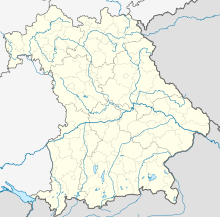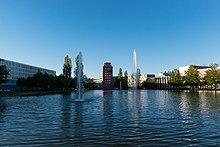| Munich-Riem Airport Flughafen München-Riem | |||||||||||||||
|---|---|---|---|---|---|---|---|---|---|---|---|---|---|---|---|
 Munich-Riem Airport in 1988. Munich-Riem Airport in 1988. | |||||||||||||||
| Summary | |||||||||||||||
| Airport type | Defunct | ||||||||||||||
| Owner/Operator | Flughafen München GmbH | ||||||||||||||
| Serves | Munich | ||||||||||||||
| Location | Trudering-Riem, Bavaria | ||||||||||||||
| Opened | 25 October 1939 (1939-10-25) | ||||||||||||||
| Closed | 16 May 1992 (1992-05-16) | ||||||||||||||
| Coordinates | 48°08′16″N 011°41′25″E / 48.13778°N 11.69028°E / 48.13778; 11.69028 | ||||||||||||||
| Map | |||||||||||||||
 | |||||||||||||||
| Runways | |||||||||||||||
| |||||||||||||||
Munich-Riem Airport (German: Flughafen München-Riem) (IATA: MUC, ICAO: EDDM) was the international airport of Munich, the capital city of Bavaria and third-largest city of Germany. It was closed down on 16 May 1992, the day before the new Munich Airport commenced operations. It was located near the old village of Riem in the borough of Trudering-Riem in the east of Munich.
The area has been redeveloped into Messestadt Riem, a new urban district consisting of housing projects, a shopping mall, recreational areas and the Neue Messe München, an exhibition and convention center.
History
| This section needs additional citations for verification. Please help improve this article by adding citations to reliable sources in this section. Unsourced material may be challenged and removed. (May 2009) (Learn how and when to remove this message) |

Foundation and expansion
Construction started in 1936. The first plane landed on 25 October 1939, signalling the beginning of air traffic. At this time it was one of the most modern airports in the world. It replaced the airfield at Oberwiesenfeld (now the site of the Olympic Village).
In World War II it was home to Adolf Galland's legendary Jagdverband 44. It was almost completely destroyed by bombings on 9 April 1945. Until that day, civilian air traffic had also been handled in Riem. George Raffeld of the United States Rainbow Division was the first of the allied forces to arrive at the airport. He reported to his superior officers that the airport had been abandoned by the Germans.
After the war Munich-Riem was the first airport in Germany to be used for civil aviation. Post-war operations started on 6 April 1948 with the landing of a DC-3 operated by Pan American World Airways. On 12 October 1949 the Flughafen München-Riem GmbH (Munich-Riem Airport Ltd.) was founded. Wulf-Dieter Graf zu Castell became one of its managing directors. The airport's runway was lengthened to 1,900 metres (6,234 ft) in November 1949.
On 29 October 1958, the first jet aircraft, a Sud Aviation Caravelle operated by Air France, landed on the runway that had been lengthened by further 700 metres (2,297 ft). In 1962 more than one million passengers had passed through the airport. As early as 1963 the Öchsle Commission initiated a search for a new airport location as it was obvious that further extension would not be legally or politically possible. Constructing additional runways parallel or perpendicular to the existing one would require relocating a number of nearby communities. A number of accidents further encouraged the decision to build a new airport further away from the city and to close down Riem. In October 1965 a new maintenance hangar for jets, that had been built at a cost of DM 10 million, was put into operation and transferred to Lufthansa. In 1969 the Flughafen München-Riem GmbH was renamed Flughafen München GmbH. The main runway (07R/25L) was upgraded to its final length of 2,804 metres (9,199 ft) after it was closed for resurfacing for three weeks in August, 1969. In 1971 a new arrivals hall was put into operation, the passenger throughput having attained four million. On 31 December 1972 the long-time managing director Wulf-Dieter Graf zu Castell retired.
Later years and replacement
Since the 1980s and into the early 1990s, the airfield was heavily congested. Originally the terminal was intended to handle between five and eight million passengers per year, but by 1991 the passenger numbers had skyrocketed to twelve million passengers per year, which was 50% to more than double the number of passengers that the airport was originally designed to handle. Because the airport's taxiway system had been designed to be used as a smaller medium-size airport, it was unable to handle the large numbers of aircraft that used the airport. To continue operations preliminary annexes to the terminal were built, including a special hall for charter flights.
During the night from 16 to 17 May 1992, operations moved to the new location near Freising. The IATA airport code MUC and the ICAO airport code EDDM has been reassigned to the new Munich Airport.
Redevelopment

Re-use as cultural center (1993–1996)
During an interim time after the move, the remaining terminal buildings such as Zeppelinhalle, Charterhalle, Terminal 1 and Wappensaal were used as venues for large events such as concerts and raves. Riem was well known internationally in the techno, alternative, and rock scenes. For example, Nirvana's last concert took place there on 1 March 1994. On 17 June 1994, the Ultraschall techno club opened in what was the cafeteria's kitchen. The cultural centre was closed in the summer of 1996 because the area to be redeveloped into Messestadt Riem.
Messestadt Riem
The redevelopment of the area into Messestadt Riem ('Riem Convention City') with an eponymous convention centre, apartment houses and parks was one of Munich's largest urban planning projects in the late 1990s and at the beginning of the 21st century. In 1999, the first residents moved into the new district. The only structures that remain of the airport today are the tower and the original terminal building, the Wappenhalle (hall of the coats of arms). Both structures are protected monuments. A small stretch of the former runway still exists at the eastern end. In 2005, the former airport was the site of the Bundesgartenschau (Federal Horticultural Show).
Accidents and incidents
- On 6 February 1958 an Airspeed AS 57 Ambassador charter plane crashed soon after take-off. The accident – known as the Munich air disaster – cost the lives of 23 people including eight football players from Manchester United. There were 21 survivors. The British pilot, James Thain, was initially blamed for the disaster after investigators claimed that ice on the wings had caused the take-off attempt to end in tragic failure. However, Thain was finally cleared of any responsibility for the crash in 1969, by which time he and his family had suffered numerous incidents of verbal abuse, hate mail and even death threats from people accusing him of causing the crash. The cause of the crash was ultimately established as slush on the runway; there had been no ice on the wings.
- On 17 December 1960, a Convair C-131D Samaritan operated by the United States Air Force crashed shortly after take-off, killing all 20 passengers and crew on board as well as 32 people on the ground. It is one of two confirmed crashes involving an airplane and a tramway.
References
![]() This article incorporates public domain material from the Air Force Historical Research Agency
This article incorporates public domain material from the Air Force Historical Research Agency
- Hecktor, Mirko; von Uslar, Moritz; Smith, Patti; Neumeister, Andreas (1 November 2008). Mjunik Disco – from 1949 to now (in German). Blumenbar. ISBN 978-3936738476.
- Schauberger, Anja. "11 verrückte Clubs in München, die Geschichte schrieben" [11 crazy clubs in Munich that made history] (in German). Mit Vergnuegen. Retrieved 21 February 2022.
- "Messestadt". Toytown Germany. Retrieved 24 January 2015.
- DRAPER, FRANK (10 June 1969). "Munich crash pilot cleared". Evening Standard. London. p. 21. Retrieved 5 March 2023.
- "ASN Aircraft accident Airspeed AS.57 Ambassador 2 G-ALZU München-Riem Airport (MUC)".
- Accident description at the Aviation Safety Network
External links
![]() Media related to Munich Airport Riem at Wikimedia Commons
Media related to Munich Airport Riem at Wikimedia Commons
- Online archive of the old Munich-Riem Airport webarchive
- Technical information on Munich-Riem Airport and its radio beacons
- History of Messestadt Riem including history of the airport (in German)
- What became of München-Riem (in German)
- "Little Town History of Old Riem" (in German). Archived from the original on 14 July 2011. Retrieved 20 May 2010.
- "Austrian Aviation Net: Rückblick: München Riem". Archived from the original on 23 July 2011. Retrieved 20 May 2010.
- München Riem Airport Historical approach and aerodrome charts